Monday morning we had lots of whales around the mooring area as we were sipping coffee on deck before breakfast. One was pec slapping just beyond the Turks & Caicos Explorer II, moored next to us, then put on a display of lobtailing and peduncal throws. Another whale was breaching not too far away, but just far enough to be beyond the usable range of my little camera. I did not manage to get any good pictures of these behaviors, but there are several good ones in Gene's Conscious Breath Adventures Photo Gallery. I did stick my camera out off the side of the boat to catch the sunrise photo at right. With the sun already up above the horizon and blazing brightly, I was not sure whether the camera could capture it, or whether I might damage the camera in trying, but it did a pretty good job and survived just fine. To the right of the sun, you can see the wreck of the frieghter Polyxeni and the Turks & Caicos Aggressor II.
After filling up on pancakes and sausage, it was time to prepare our gear and load aboard the tenders to go whale watching. Gene likes to switch tenders on alternate days to swim with all of the guests, so on Monday our in-water naturalist was Cruise Director Brandon Shannon, filling in for the injured Clare Omodei. It takes more than just a set of fins and a willingness to get wet to fill in on this job, but Brandon's several seasons working on different boats visiting the Silver Bank have given him the necessary familiarity with Humpback Whales and their behaviors to do well in the job.

We saw this scene for quite a while: Captain Eddy communicating with Brandon as he swam around with a slow-moving mother, calf, and escort. They told us that the whales will often move a short distance before resuming their sleep, so we were hoping this trio would come to a stop at some point. They did not. Brandon got in and swam over to them a few times, but each time they moved along before we could all get in the water.
At one point, the mother and calf turned and headed right toward our boat. When the whales are nearby, it is usually easy to see thier white pectoral fins in the deep blue water, so I was prepared when they came to the surface and got off a picture.

The whales went under the boat, and I was thinking it would be nice if we could just jump over the side and swim with them, but knew that would be against the rules. Then I remembered just in time that I was holding my waterproof camera in my hand, so I stuck it in the water over the side of the boat and got off a couple of pictures of mom and calf as they swam under.
One more shot as they faded out of sight. It was a bit hard to get used to plunging my camera under water at first, but I have become more accustomed to it. It still feels a bit unnatural to take a camera and stick it in the ocean, but it's a good trick for getting an underwater photo of the whales when getting in the water with them is not possible.

I was a bit more prepared when their escort decided to come under the boat. This one has a large, white scar on the left side of his face. The facial scarring marks this guy as a Stellwagen Bank whale, and the fact that it is on the left side means he is a lefty. Left "pected" instead of left handed, I suppose, but he scrapes the bottom for food on his left side, while most of the Stellwagen Bank whales do it on the right. Whales come from all over the North Atlantic to the Silver Bank, but only the Stellwagen whales have this characteristic scarring.
I had the camera set to shoot continuously and just fired away as the escort swam under the boat. Is it strange that my wife likes this whale just because he is a fellow lefty in a world of righties?

We gave up on the mom, calf, and lefty escort after a while. They did not seem inclined to settle down and rest, but kept slowly moving along. We went off in search of other whales. Often the first thing you see is the blow when they breathe and soon we came across this "rowdy" group. That is actually a scientific classification, not just a characterization on my part. Groups of male Humpback Whales are called "rowdies" and this rowdy group showed us a bit of why they got that name. I'm guessing a British scientist came up with the term, but that's just wild speculation on my part.
There was no chance of getting in the water with these whales, and the way they seemed to enjoy ramming and sideswiping each other, I'm not so sure it would have been a great idea if it were possible. They seemed to be about as capable of holding still as teenage boys, so they were fun to watch from the boat, but moving way too fast to let us get in the water with them.
As we rode along watching them and taking pictures and videos, the rowdy group led us back toward the moored liveaboard fleet. In the background you can see the Turks and Caicos Explorer and the Sun Dancer II.

It was impossible to tell how many whales were in this group, but we think there were 7. They never surfaced simultaneously, so we were not sure how many were beneath these three when they came up to blow together.
And down they go! This group of whales completely ignored the boat as we cruised along 100 feet or so beside them. They were much too busy bumping into each other to care what we were doing. It was kind of like watching a waterborne demolition derby involving really reckless submarine drivers. Brandon seemed pretty unimpressed because this group was being so tame for a rowdy bunch, making me wonder what it is like when they really get worked up.

I caught this picture just as one of the whales blew. It's really an explosive spout, and they do it just before the blowhole breaks the surface, sending a huge cloud of mist into the air. Humpbacks expel and replace 90% of the air in their lungs with each blow, a much larger percentage than humans, and they use much more of the available oxygen than we do as well. That's why a huge female Humpback, who requires a great deal of oxygen even when at rest, can stay down for a half an hour on a breath of air.
Humpback whales got their name from the small hump forward of the dorsal fin, and from their technique of humping their backs when they dive, both shown beautifully in this picture taken by Elliot Davidson. Elliot is a film teacher in his native Australia, and it is the auto shutter on his nice camera that can sometimes be heard in the videos accompanying these pages. Thanks again for sharing, Elliot!
This whale has marks on his dorsal fin that look sort of like teeth marks to me. One of the hazards faced by young Humpbacks on their first migration north is being eaten by Orcas or large sharks. Looks like this one had a close call in his past!

The rowdy group took us back to the mooring area at about lunch time, so we went back to the Sun Dancer II. After a quick hot shower on the dive deck and drying off a bit, I made my way up to the Lido deck, where people were watching a baby Humpback breaching not far from the boat. I tried to get some pictures, but none showing the whale came out well. I did get one picture of a terrific splash. I wished one of the adults would breach near my camera, but most seemed to observe the rule that whales breach only on the horizon.
Clare was unable to participate in the whale diving and spent the week taking pictures of all of us from the big boat, so I decided someone should take a picture of her! The light patches in the water beyond her are coral head formations that rise from 60 feet or so of depth to the surface. Further in the background, it is possible to see the reef line and the rougher waves of the Atlantic Ocean beyond. The wind was picking up, and when that happens there are a lot of whitecaps on the surface and the waves break over the coral formations. The splashing off the irregular corals can send water straight up into the air, and is easily mistaken for a whale breaching or spouting in the distance. The running joke was that the reefs were breaching.

Jerry and Carlos made us a delicious lunch of chicken with black beans and rice, coleslaw, and fruit salad, and sitting on the aft deck after lunch I was feeling a bit sluggish. The wind had picked up to around 20 knots, the Sun Dancer II was rolling gently as she swung on the mooring, and I was starting to think that napping sounded like more fun than going out in a 25 foot boat. Gene had taken Oswaldo and Amy out in the tender to try to tag some whales, and I could see them returning from their mission in the distance.
SPLASH! That settled it for me. A breaching tender does not look like fun, and we still had plenty of days to watch whales. Sonja and I decided to take the afternoon off. I went down to the dive deck to ask Oswaldo and Amy how the mission went, and they reported tagging one whale with a satellite tracker. Pretty impressive! I did not want to go out in those boats in the strong wind and waves, but Amy got up on the bow and shot a dart at a moving whale. Before this trip, I had a certain picture of what a whale researcher might be like, and what one might do in the course of whale research. I did not really picture a girl wearing a harness to perch up on the bow of a bouncing boat with a ship's line throwing gun in her hand. I did not really picture a Dominican fish farm owner with a taste for fine rum and a talent for salsa dancing either, but that's what Amy and Oswaldo turned out to be, among other things. A fascinating pair.
Off went the tenders for the afternoon whale encounters. I was sorry to skip the trip, but had a nice nap and woke feeling refreshed. I had been too excited to sleep well in the days leading up to the trip, and the start of the trip was such a frenzy of activity that I was exhausted. I think that afternoon was the first time I really caught up and felt well.

We had a nice sunset that evening at the Lido Deck bar Sundowner Party. Here Oswaldo is explaining something to Sonja as Kris (foreground) and I listen in.
A colorful sunset with a warm, tropical breeze. We were looking for a green flash, not an uncommon event out on the Silver Bank, but did not see one.

We had a great shrimp dinner, or at least most of us did. Gene eschews shrimp because of bycatch issues with harvested wild shrimp and environmental concerns about shrimp farming. He said he would eat them if we went out and netted them ourselves, so that's on my list now. Dinner conversation centered around shrimp and salmon farming and fishing and related conservation issues. Gene told us about the Monterey Bay Aquarium Seafood Watch list, which can educate consumers about where fish actually come from and which ones are sustainable and which are not. It was interesting to hear the different perspectives on the subject from Oswaldo, who is also a fish farmer, Amy the whale researcher, and Elliot the Aussie teacher. After dinner, I snapped the candid photo at right of Barefoot Captain Eddy, my kind of captain!
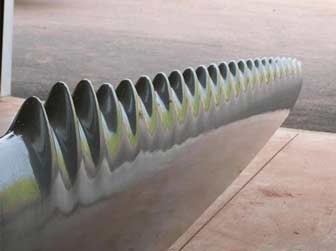 Tubercle Windmill Blade by Whalepower
Tubercle Windmill Blade by WhalepowerGene did a slideshow presentation after dinner on whales and biomimetic engineering. The idea of biomimetic engineering is to look at a design solution in the natural world and apply it to human technology. In the case of the Humpback whales, studying them has led to more efficient propellers. That got my attention right away, as propellers drive several of my boats.
The giant pectoral fins of Humpback whales have bumps along the leading edge called tubercles. It makes for a very bumpy and uneven leading edge, something that did not really strike me as strange until Gene mentioned it. I'm a pilot, but none of the airplanes I have ever seen have bumpy leading edges on propellers or wings. High performance gliders certainly do not want bumps on their wings. Why would Humpback whales have these bumps on their "wings"?
The answer turns out to be: because they are more efficient that way! The tubercles disrupt the lateral flow of water out toward the tip of the pectoral fins, forcing more of it to flow over the fins instead. That flow over the surface is what gives pectoral fins, or any other kind of wing, lift.
Observant scientists figured this out, and Whalepower has applied the technology to the wind turbine blade in the picture. That one really got my attention, and right away I had visions of going home and taking a file to various propellers. Also, it occurred to me that the fins on my Hobie Mirage Drive are not unlike whale pectoral fins, so I now wonder what will happen if I put blobs of 3M 5200 along the leading edges of the fins, just like tubercles on the whales. I started thinking about taking chunks out of sailboat rudders next, and decided I had better go to bed before I dreamed up any more destruction of perfectly operational boats. So ended Monday.
See the video below of our second day's activities.

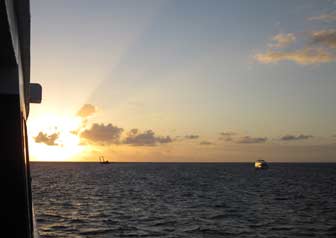
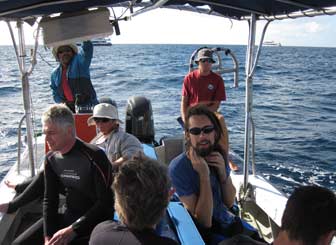
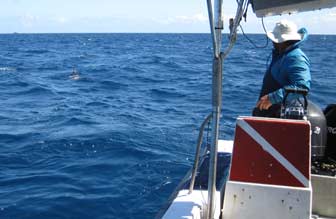
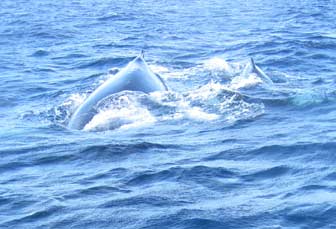
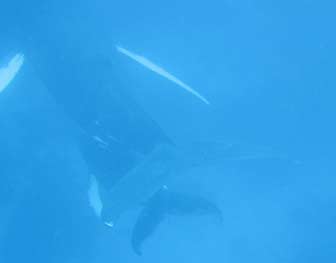
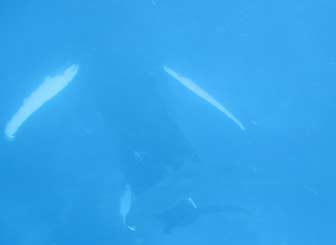
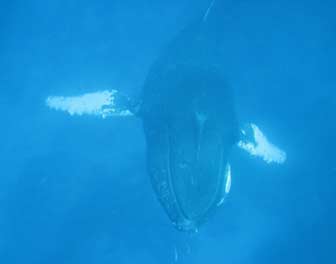
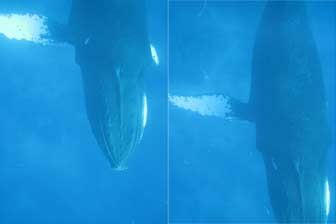
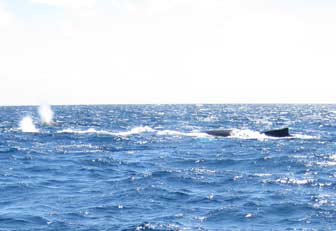
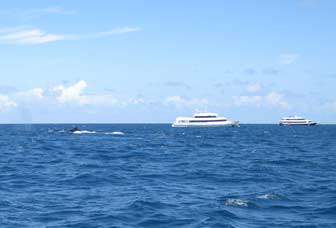
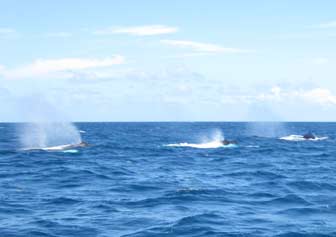
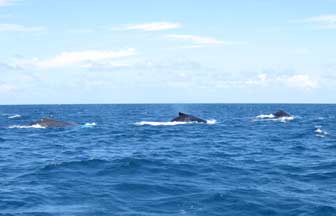
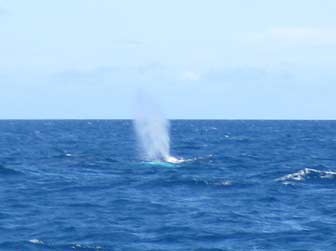
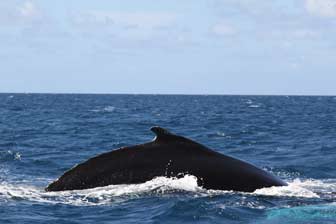
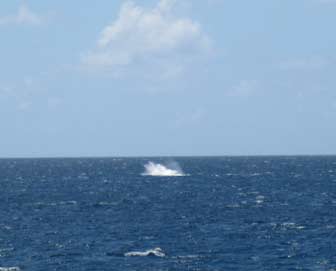
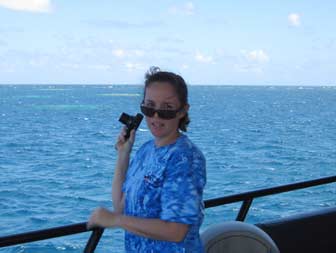
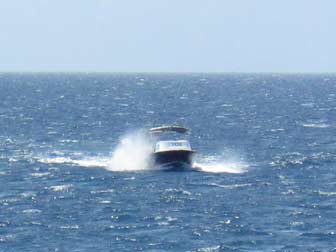
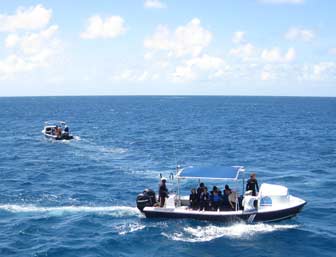
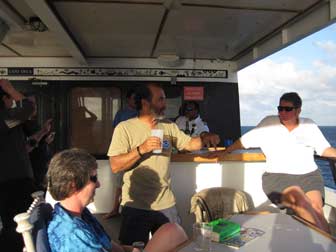
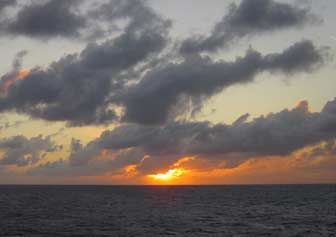
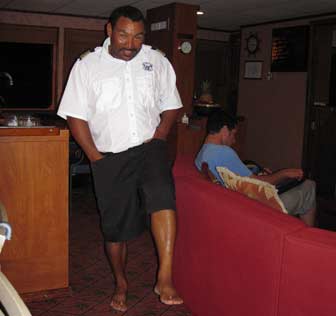
Leave a Reply
You must be logged in to post a comment.